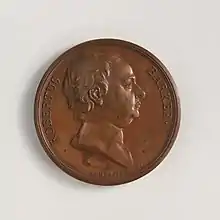Robert Barker (physician)
Robert Barker (died 1745) was a British physician and inventor. He was a Fellow of the Royal Society from 1732.[1]

Barker invented both a reflecting microscope, exhibited in 1736, and "Barker's mill", a prototype reaction turbine (1743).[2][3] According to James Dodson, he was a friend of Charles Labelye.[4] He died in London, on 9 September 1745.[5]
Barker's Mill
Barker's Mill, a rotating device powered by water and Newton's Third Law, is sometimes described as a 17th century invention.[6] It is attributed to Dr Robert Barker F.R.S., in 1743. It was published by John Theophilus Desaguliers in his book Experimental Philosophy of 1744.[7][3] Desaguliers, who himself demonstrated the mill to the Royal Society, attributed the principle involved to Antoine Parent.[8] French terms for the mill are tourniquet hydraulique, moulin de Parent or roue à réaction.[9][10]
A complex timeline of development ensued.
- As the Segner wheel, practical application of the idea is often credited to Johann Andreas Segner (1750).[7]
- Leonhard Euler with the Euler wheel of 1754 developed Segner's concept.[9]
- James Ferguson the lecturer notices in 1767 "a model of Dr. Barker's water mill".[11]
- c.1790 James Rumsey had an "improvement upon Dr. Barker’s mill: a mode to allow circular or retrograde motion mills with a smaller quantity of water to be moved or turned".[12]
- 1827 water turbine of Benoît Fourneyron.[13]
- In 1839 James Whitelaw and James Stirrat of Paisley obtained a patent for a water turbine based on "Barker's Mill".[14]
Notes
- "Royal Society Fellow details Barker; Robert (- 1745)". Retrieved 8 August 2018.
- Ratcliff, Marc J. (24 February 2016). The Quest for the Invisible: Microscopy in the Enlightenment. Routledge. p. 30. ISBN 9781317018407. Retrieved 8 August 2018.
- Dickinson, Henry Winram (17 February 2011). A Short History of the Steam Engine. Cambridge University Press. p. 187. ISBN 9781108012287. Retrieved 8 August 2018.
- Dodson, James (1742). The Anti-logarithmic Canon: Being a Table of Numbers, Consisting of Eleven Places of Figures, Corresponding to All Logarithms Under 100000 ... With Precepts and Examples ... To which is Prefix'd, an Introduction, Containing a Short Account of Logarithms ... J. Dodson and J. Wilcox. p. x. Retrieved 9 August 2018.
- Hawkins, Edward, Herbert Appold Grueber (1885). "Medallic illustrations of the history of Great Britain and Ireland to the death of George II". Internet Archive. London: British Museum. p. 588. Retrieved 9 August 2018.
{{cite web}}: CS1 maint: multiple names: authors list (link) - Chisholm, Hugh, ed. (1911). . Encyclopædia Britannica. Vol. 3 (11th ed.). Cambridge University Press.
- Project Technology, Schools Council (Great Britain) (1975). Industrial Archaeology of Watermills & Waterpower. Heinemann Educational Books. p. 85. ISBN 9780435759100. Retrieved 8 August 2018.
- Musson, Albert Edward; Robinson, Eric (1989). Science and Technology in the Industrial Revolution. Taylor & Francis. p. 45. ISBN 9782881243820. Retrieved 8 August 2018.
- Viollet, Pierre-Louis (2005). Histoire de l'énergie hydraulique: moulins, pompes, roues et turbines de l'Antiquité au XXe siècle (in French). Presses des Ponts. p. 139. ISBN 9782859784140. Retrieved 8 August 2018.
- Recueil de la Société polytechnique: ou Recueil industriel, manufacturier, agricole et commercial, de la salubrité publique, et des actes de l'administration propres à encourager les diverses branches de l'économie publique. Société polytechnique. 1828. p. 119.
- Ferguson, James; Henderson, Ebenezer (1867). Life of James Ferguson, F. R. S.: In a Brief Autobiographical Account, and Further Extended Memoir. A. Fullarton. p. 154. Retrieved 8 August 2018.
- "Rumsey Exhibit – 3-4 – the Museum of the Berkeley Springs". Retrieved 8 August 2018.
- Hall, A. Rupert; Smith, Norman (30 September 2016). History of Technology. Bloomsbury Publishing. p. 238. ISBN 9781350017382. Retrieved 9 August 2018.
- "Whitelaw and Stirrat, Grace's Guide". Retrieved 8 August 2018.